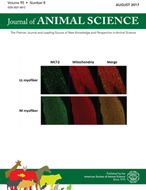-
Views
-
Cite
Cite
J. Cao, P. R. Henry, R. Guo, R. A. Holwerda, J. P. Toth, R. C. Littell, R. D. Miles, C. B. Ammerman, Chemical characteristics and relative bioavailability of supplemental organic zinc sources for poultry and ruminants, Journal of Animal Science, Volume 78, Issue 8, August 2000, Pages 2039–2054, https://doi.org/10.2527/2000.7882039x
Close - Share Icon Share
Abstract
Eight commercially available organic Zn products and reagent-grade ZnSO4 · 7H2O (Zn Sulf) were evaluated by polarographic analysis, and solubility in .1 M K2HPO4-KH2PO4 buffer (pH 5), .2 M HCl-KCl buffer (pH 2), and deionized water. Fractions from these solubility tests were evaluated by gel filtration chromatography for structural integrity. Degree of chelation was generally positively related to chelation effectiveness determined by polarography. The organic sources were Zn methionine complex A (Zn MetA), Zn methionine complex B (Zn MetB), Zn polysaccharide complex (Zn Poly), Zn lysine complex (Zn Lys), Zn amino acid chelate (Zn AA), Zn proteinate A (Zn ProA), Zn proteinate B (Zn ProB), and Zn proteinate C (Zn ProC). Three experiments were conducted to estimate the relative bioavailability of Zn from the organic Zn supplements for chicks and lambs when added at high dietary levels to practical diets. Bone Zn concentration increased (P < .001) as dietary Zn increased in both experiments. When Zn Sulf was assigned a value of 100% as the standard, multiple linear regression slope ratios of bone Zn from chicks fed 3 wk regressed on dietary Zn intake gave estimated relative bioavailability values of 83 ± 14.6 and 139 ± 16.9 for Zn AA and Zn ProA, respectively, in Exp. 1 and 94 ± 11.6, 99 ± 8.8, and 108 ± 11.4 for Zn Poly, Zn ProB, and Zn ProC, respectively, in Exp. 2. In Exp. 3, 42 lambs were fed diets containing Zn Sulf, Zn ProA, Zn AA, or Zn MetB for 21 d. Based on multiple linear regression slope ratios of liver, kidney, and pancreas Zn and liver metallothionein concentrations on added dietary Zn, bioavailability estimates relative to 100% for Zn Sulf were 130, 110, and 113 for Zn ProA, Zn AA, and Zn MetB, respectively. Except for Zn ProA, which was greater, the organic Zn supplements had bioavailability values similar to that of Zn Sulf for chicks and lambs. Bioavailability of organic Zn products was inversely related to solubility of Zn in pH 5 buffer in chicks (r2 = .91) and pH 2 buffer in lambs (r2 = .91), but not to an estimate of degree of chelation.





